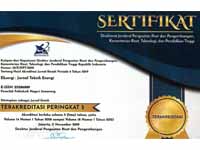Rancang Bangun Turbin Angin Poros Horizontal Double Multiflat Blade
DOI:
https://doi.org/10.32497/eksergi.v15i3.1789Keywords:
turbin angin poros horizontal, turbin angin multiblades, sudut blade, kecepatan angin, efisiensi sistemAbstract
Tujuan dari penelitian Turbin Angin Poros Horizontal Double Multiflat Blade adalah membandingkan kinerja turbin angin poros horizonal single multiflat blade dengan turbin angin poros horizontal double multiflat blade perlakuan sisi masuk dan perlakuan sisi keluar. Pengujian turbin angin single multiflat blade dilakukan pada kecepatan angin 5 m/s, 7 m/s, dan 9 m/s dengan sudut blade 35 °, 38 °,40 °, 43 ° dan 45 °. Berdasarkan pengujian, turbin angin single multiflat blade pada kecepatan angin 9 m/s dan sudut blade 40 ° menghasilkan efisiensi sistem tertinggi yaitu 8,397%. Kecepatan dan sudut tersebut digunakan untuk pengujian turbin angin double multiflat blade. Pengujian turbin angin double multiflat blade dengan perlakuan sisi keluar, efisiensi sistem tertinggi yaitu 11,74%, sedangkan pengujian turbin angin double multiflat blade dengan perlakuan sisi masuk, efisiensi sistem tertinggi yaitu 5,16%. Kesimpulan dari pengujian adalah efisiensi sistem tertinggi dihasilkan pada pengujian turbin angin poros horizontal double multiflat blade perlakuan pada sisi keluar dengan kecepatan angin 9 m/s dan sudut blade 40 ° sebesar11,74%.
Downloads
Published
Issue
Section
License
Authors who publish with this journal agree to the following terms:Authors retain copyright and grant the journal right of first publication with the work simultaneously licensed under a Creative Commons Attribution License that allows others to share the work with an acknowledgement of the work's authorship and initial publication in this journal.
Authors are able to enter into separate, additional contractual arrangements for the non-exclusive distribution of the journal's published version of the work (e.g., post it to an institutional repository or publish it in a book), with an acknowledgement of its initial publication in this journal.
Authors are permitted and encouraged to post their work online (e.g., in institutional repositories or on their website) prior to and during the submission process, as it can lead to productive exchanges, as well as earlier and greater citation of published work (See The Effect of Open Access).






